Method for the Evaluation of the Homogeneity of Asphalt Mixtures by 2-Dimensional Image Analysis
Abstract
:1. Introduction
2. Experimental Study
2.1. Materials
2.2. Experiment Design
2.3. Imaging of Cross Section
2.3.1. Specimen Preparation
2.3.2. Cutting Prepared Specimens
- (i)
- Random: the selected section is independent and random.
- (ii)
- Representative: asphalt mixture is a kind of heterogeneous material, so it is necessary to select the section that can represent the internal characteristics of the asphalt mixture to the greatest extent.
- (iii)
- Isotropic: Asphalt mixture section images should be selected in the same direction. For example, all sections of the specimen are perpendicular to or parallel to the compaction direction.
2.3.3. Sectional Image Acquisition
3. Homogeneity Evaluation Parameters of Asphalt Mixture
3.1. Image Processing
3.2. Aggregate Particle Size Distribution through Image Processing
3.2.1. Minimum Size of Aggregate Identifiable in the Image
3.2.2. Image-Based Aggregate Gradation (i.e., Virtual Gradation)
3.3. Homogeneity Evaluation Parameters Analysis
3.3.1. Region Division
3.3.2. Evaluation Parameter of Aggregate Distribution Homogeneity
3.3.3. Evaluation Parameter of Air Voids Distribution Homogeneity
3.3.4. Evaluation Index of Asphalt Mixture Homogeneity
3.4. Rationality of Homogeneity Coefficient
4. Factors Controlling the Homogeneity of Asphalt Mixture
4.1. Nominal Maximum Aggregate Size
4.2. Aggregate Gradation
4.3. Filler–Binder Ratio
- (1)
- When the filler–binder ratio was lower (i.e., larger asphalt content), the free asphalt in the asphalt mixture was excessive. At this time, the asphalt not only played a role of binder, but also played a role of lubricant. As a result, the bonding force of asphalt mixture and the interlock force between aggregates decreased. In the compaction process, the displacement between aggregate particles was more likely to occur because there was not enough force to constrain the aggregates, resulting in poor uniformity of asphalt mixture.
- (2)
- When the filler–binder ratio was optimal, the corresponding bonding force and friction resistance of asphalt mixture were moderate. During the compaction process, aggregate particles could be distributed along the optimal trajectory, which made the aggregate particles more evenly distributed in the asphalt mixture.
- (3)
- When the filler–binder ratio was higher, that is, when the asphalt content was insufficient, there was not enough asphalt to form framework asphalt. Meanwhile, the asphalt film thickness was thicker and the friction between aggregates was larger, which would constrain the normal movement trajectory of aggregates and lead to poor uniformity of asphalt mixture.
5. Conclusions
- (1)
- Based on digital image-processing technique and stereology theory, combined with the virtual aggregate gradation obtained through section images, the distribution characteristics of the inner-structure of components of asphalt mixture can be effectively identified.
- (2)
- The homogeneity coefficient K was proposed to characterize the distribution homogeneity of the asphalt mixture, which could describe the distribution homogeneity of coarse aggregates and air voids comprehensively. For the asphalt mixture with a larger quantity K, it means that the distribution of coarse aggregates and air voids in the asphalt mixture are rather inhomogeneous.
- (3)
- There are strong correlations between the homogeneity coefficient and design factors. With the increase of nominal maximum aggregate size and of the coarseness of aggregate gradation, the homogeneity of asphalt mixture becomes worse. Too much or too little asphalt content is not conducive to the homogeneity of the asphalt mixture. The above results are consistent with previous research rules and further verify the reliability of homogeneity coefficient.
- (4)
- The suggested values of homogeneity coefficient provide theoretical support for the design of asphalt mixture. It should be noted that the suggested values of homogeneity coefficient are applicable specifically to the compaction method used in this paper and the mixtures studied.
Author Contributions
Funding
Institutional Review Board Statement
Informed Consent Statement
Data Availability Statement
Acknowledgments
Conflicts of Interest
References
- Ma, T.; Wang, Z.; Zhao, Y.; Huang, X. Evaluation of dispersive performance of asphalt mixture during mixing of hot in-place recycling. J. Harbin Inst. Technol. 2011, 43, 128–131. [Google Scholar]
- Peng, Y.; Xu, X. Numerical analysis of effect of aggregate distribution on splitting strength of asphalt mixtures. J. Zhejiang Univ. 2013, 47, 1186–1191. [Google Scholar] [CrossRef]
- Chen, C.; Williams, R.C.; Ahmed, E.T.; Lee, H.D.; Schram, S. Quality control/quality assurance testing for longitudinal joint density and segregation of asphalt mixtures. Constr. Build. Mater. 2013, 47, 80–85. [Google Scholar] [CrossRef] [Green Version]
- Airey, G.D.; Collop, A.C. Mechanical and structural assessment of laboratory-and field-compacted asphalt mixtures. Int. J. Pavement Eng. 2016, 17, 50–63. [Google Scholar] [CrossRef] [Green Version]
- Cao, W.; Liu, S.; Xue, Z.; Chen, L.; Zhang, Z. Laboratory method to characterize coarse aggregate segregation for HMA. J. Mater. Civil Eng. 2021, 33, 04020412. [Google Scholar] [CrossRef]
- Yu, H.; Yang, M.; Qian, G.; Cai, J.; Zhou, H.; Fu, X. Gradation segregation characteristic and its impact on performance of asphalt mixture. J. Mater. Civil Eng. 2021, 33, 04020478. [Google Scholar] [CrossRef]
- Chun, S.; Kim, K.; Park, B.; Greene, J. Evaluation of the effect of segregation on coarse aggregate structure and rutting potential of asphalt mixtures using Dominant Aggregate Size Range (DASR) approach. KSCE J. Civ. Eng. 2018, 22, 125–134. [Google Scholar] [CrossRef]
- Zhang, K.; Sun, P.; Li, L.; Zhao, Y.; Zhao, Y.; Zhang, Z. A novel evaluation method of aggregate distribution homogeneity for asphalt pavement based on the characteristics of texture structure. Constr. Build. Mater. 2021, 306, 124927. [Google Scholar] [CrossRef]
- Stroup-Gardiner, M.; Law, M.; Nesmith, C. Using infrared thermography to detect and measure segregation in hot mix asphalt pavements. Int. J. Pavement Eng. 2000, 1, 265–284. [Google Scholar] [CrossRef]
- Wu, J.; Romero, P. Analysis of multivariate models for evaluating segregation in hot-mix asphalt pavements. Transp. Res. Rec. 2004, 1900, 33–40. [Google Scholar] [CrossRef]
- Hu, C.; Wang, D.; Thyagarajan, S. Homogeneity evaluation of compacted asphalt mixture based on X-ray computed tomography. J. Chang’an Univ. 2010, 30, 24–28. [Google Scholar] [CrossRef]
- Sefidmazgi, N.R.; Tashman, L.; Bahia, H.U. Internal structure characterization of asphalt mixtures for rutting performance using imaging analysis. Road Mater. Pavement Des. 2012, 13 (Suppl. S1), 21–37. [Google Scholar] [CrossRef]
- Coenen, A.R.; Kutay, M.E.; Sefidmazgi, N.R.; Bahia, H.U. Aggregate structure characterisation of asphalt mixtures using two-dimensional image analysis. Road Mater. Pavement Des. 2012, 13, 433–454. [Google Scholar] [CrossRef]
- Bruno, L.; Parla, G.; Celauro, C. Image analysis for detecting aggregate gradation in asphalt mixture from planar images. Constr. Build. Mater. 2012, 28, 21–30. [Google Scholar] [CrossRef]
- Zhang, K.; Zhang, Z.; Luo, Y.; Huang, S. Accurate detection and evaluation method for aggregate distribution uniformity of asphalt pavement. Constr. Build. Mater. 2017, 152, 715–730. [Google Scholar] [CrossRef]
- Hunter, A.; Airey, G.; Collop, A. Aggregate orientation and segregation in laboratory compacted asphalt samples. Transp. Res. Rec. 2004, 1891, 8–15. [Google Scholar] [CrossRef]
- Wu, W.; Li, Z.; Zhang, X. Evaluation of asphalt mixture homogeneity with digital image processing technique. J. Jilin Univ. 2009, 39, 921–925. [Google Scholar] [CrossRef]
- Thyagarajan, S.; Tashman, L.; Masad, E.; Bayomy, F. The heterogeneity and mechanical response of hot mix asphalt laboratory specimens. Int. J. Pavement Eng. 2010, 11, 107–121. [Google Scholar] [CrossRef]
- Zhang, J.; Liu, H.; Wang, P.; Pei, J.; Bao, D.; Jin, L. Evaluation of aggregate gradation and distributing homogeneity based on the images of asphalt mixture. Road Mater. Pavement Des. 2017, 18, 1–11. [Google Scholar] [CrossRef]
- Li, X.; Lv, X.; Zhou, Y.; Diab, A.; Chen, Y.; Cui, Z.; You, Z. Homogeneity evaluation of hot in-place recycling asphalt mixture using digital image processing technique. J. Clean. Prod. 2020, 258, 120524. [Google Scholar] [CrossRef]
- Peng, Y.; Sun, L. Towards an Index of Asphalt Mixture Homogeneity. Road Mater. Pavement Des. 2009, 10, 545–567. [Google Scholar] [CrossRef]
- Peng, Y.; Sun, L. Horizontal homogeneity in laboratory-compacted asphalt specimens. Road Mater. Pavement Des. 2014, 15, 911–924. [Google Scholar] [CrossRef]
- Peng, Y.; Harvey, J.; Sun, L. Three-dimensional discrete-element modeling of aggregate homogeneity influence on indirect tensile strength of asphalt mixtures. J. Mater. Civil Eng. 2017, 29, 04017211. [Google Scholar] [CrossRef]
- Peng, Y.; Sun, L. Aggregate distribution influence on the indirect tensile test of asphalt mixtures using the discrete element method. Int. J. Pavement Eng. 2017, 18, 668–681. [Google Scholar] [CrossRef]
- JTG F40-2004; Technical Specifications for Construction of Highway Pavements. Ministry of Transport of the People’s Republic of China: Beijing, China, 2004.
- JTG E20-2011; Standard Test Methods of Bitumen and Bituminous Mixtures for Highway Engineering. Ministry of Transport of the People’s Republic of China: Beijing, China, 2011.
- Wu, W.; Wang, D.; Zhang, X.; Li, Z. Stereology method of estimation gradation of asphalt mixtures. China J. Highw. Transp. 2009, 22, 29–33. [Google Scholar]
- Sefidmazgi, N.R. Hot Mix Asphalt Design to Optimize Construction and Rutting Performance Properties. Ph.D. Thesis, University of Wisconsin, Madison, VI, USA, 2014. [Google Scholar]
- Otsu, N. A threshold selection method from gray-level histograms. IEEE Trans. Syst. Man Cybern. 2007, 9, 62–66. [Google Scholar] [CrossRef] [Green Version]
- Sha, A.; Wang, C.; Sun, C. An image-based mineral gradation measurement method of asphalt mixture. J. Chang’an Univ. 2010, 30, 1–5. [Google Scholar]
- Coenen, A.R. Image Analysis of Aggregate Structure Parameters as Performance Indicators of Rutting Resistance. Ph.D. Thesis, University of Wisconsin, Madison, WI, USA, 2011. [Google Scholar]
- Guo, N.; You, Z.; Tan, Y.; Zhao, Y.; Jing, H. Evaluation method for homogeneity of asphalt mixtures based on CT technique. China J. Highw. Transp. 2017, 30, 1–9. [Google Scholar] [CrossRef]
- Guo, N.; Wang, C.; Zhao, Y.; Tan, Y.; You, Z. Homogeneity of internal structure of asphalt mixtures based on density of inclusions. Eng. Mech. 2016, 33, 249–256. [Google Scholar] [CrossRef]
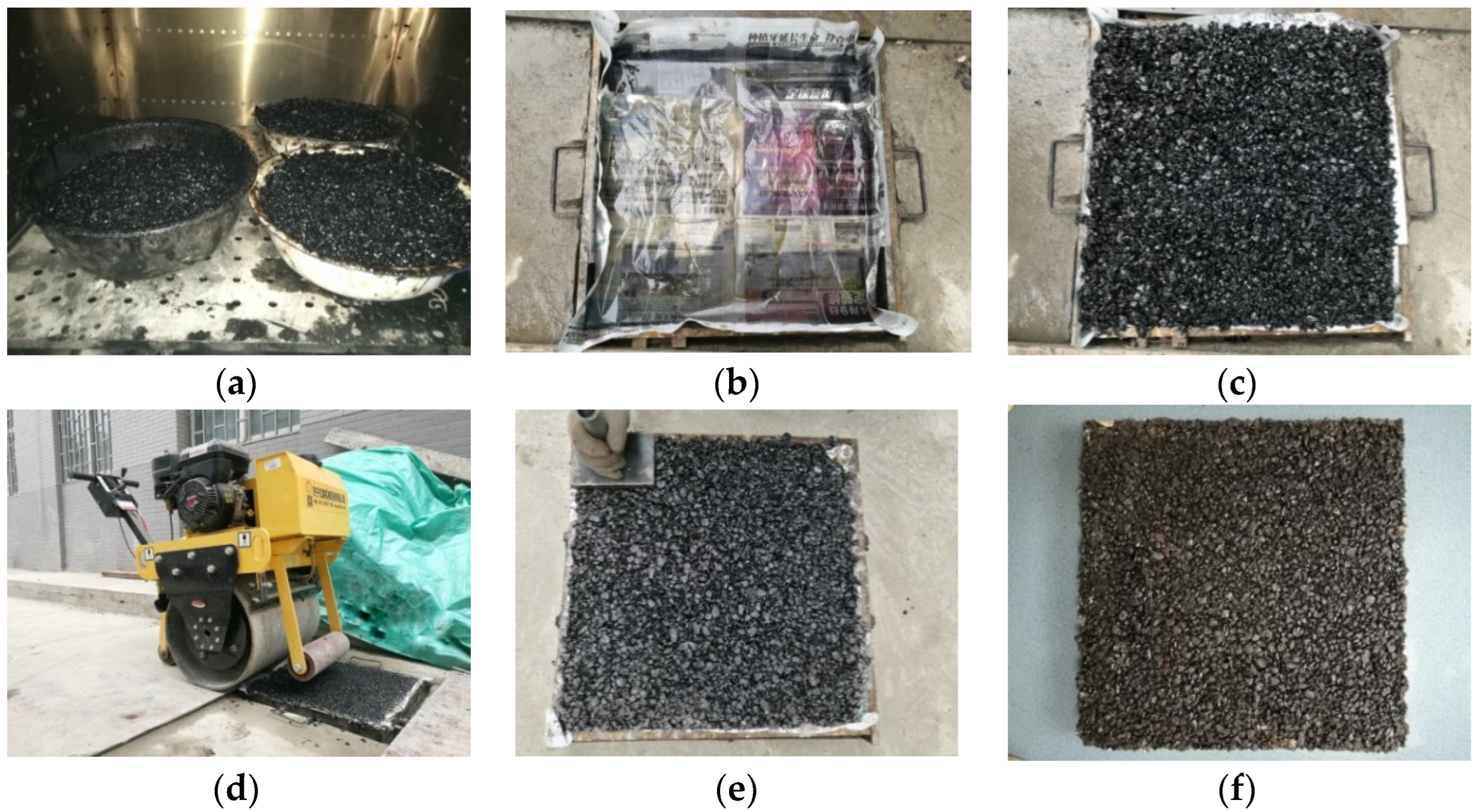
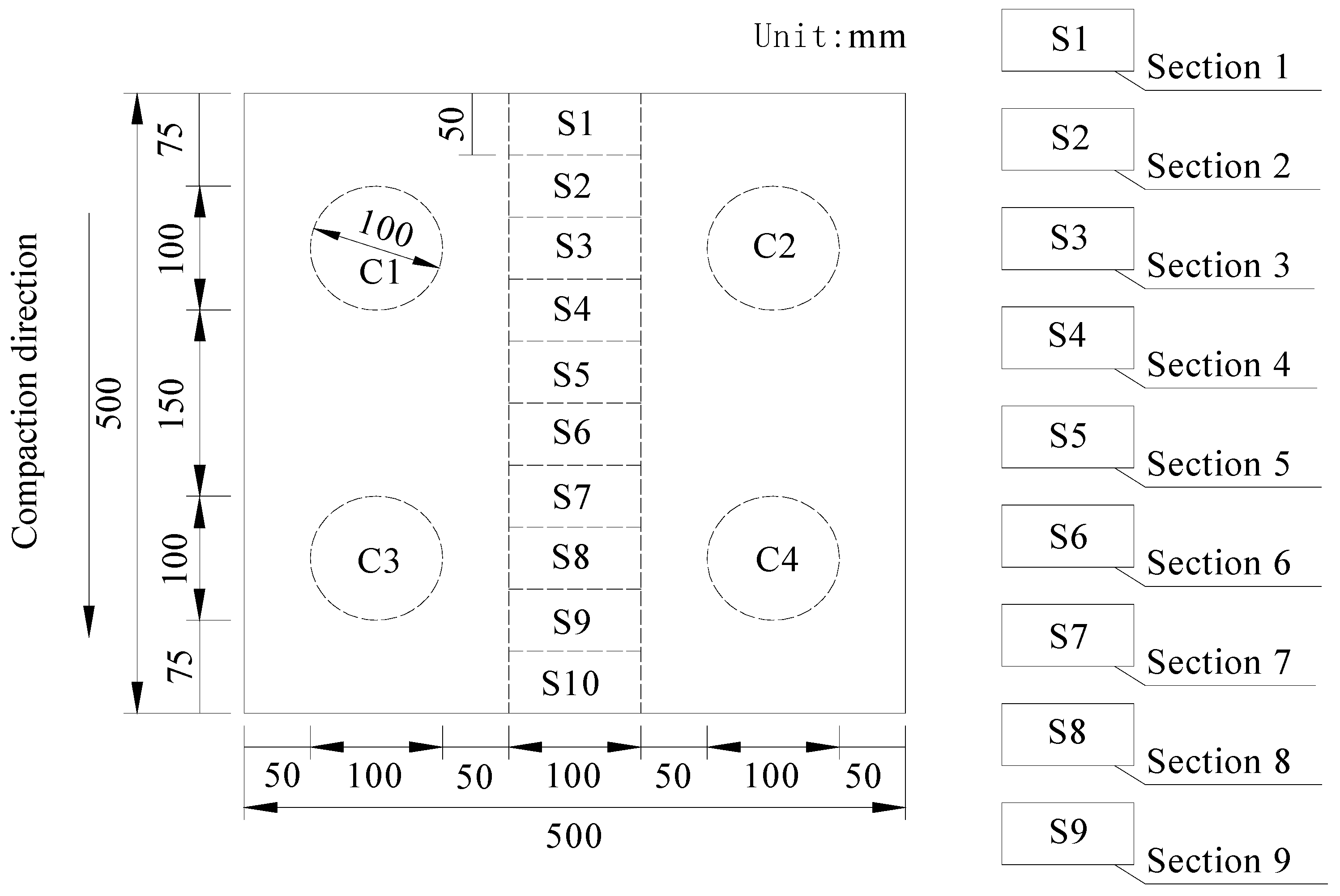
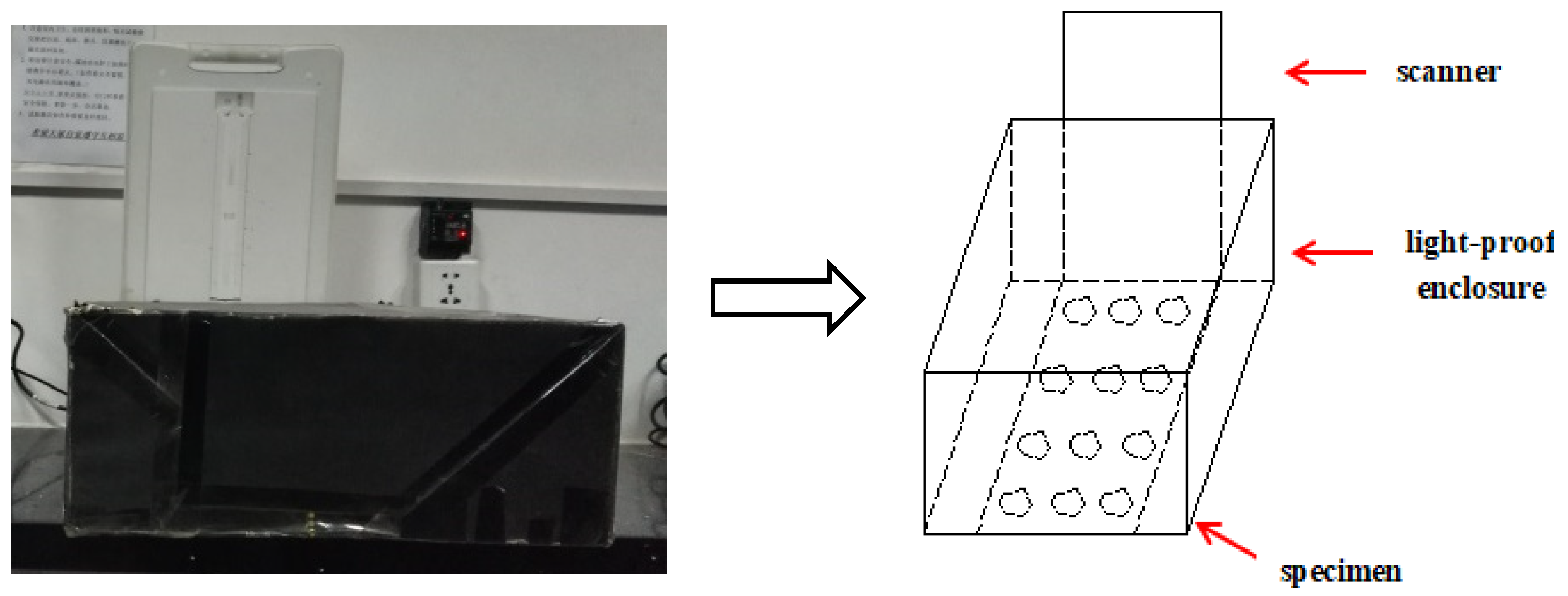


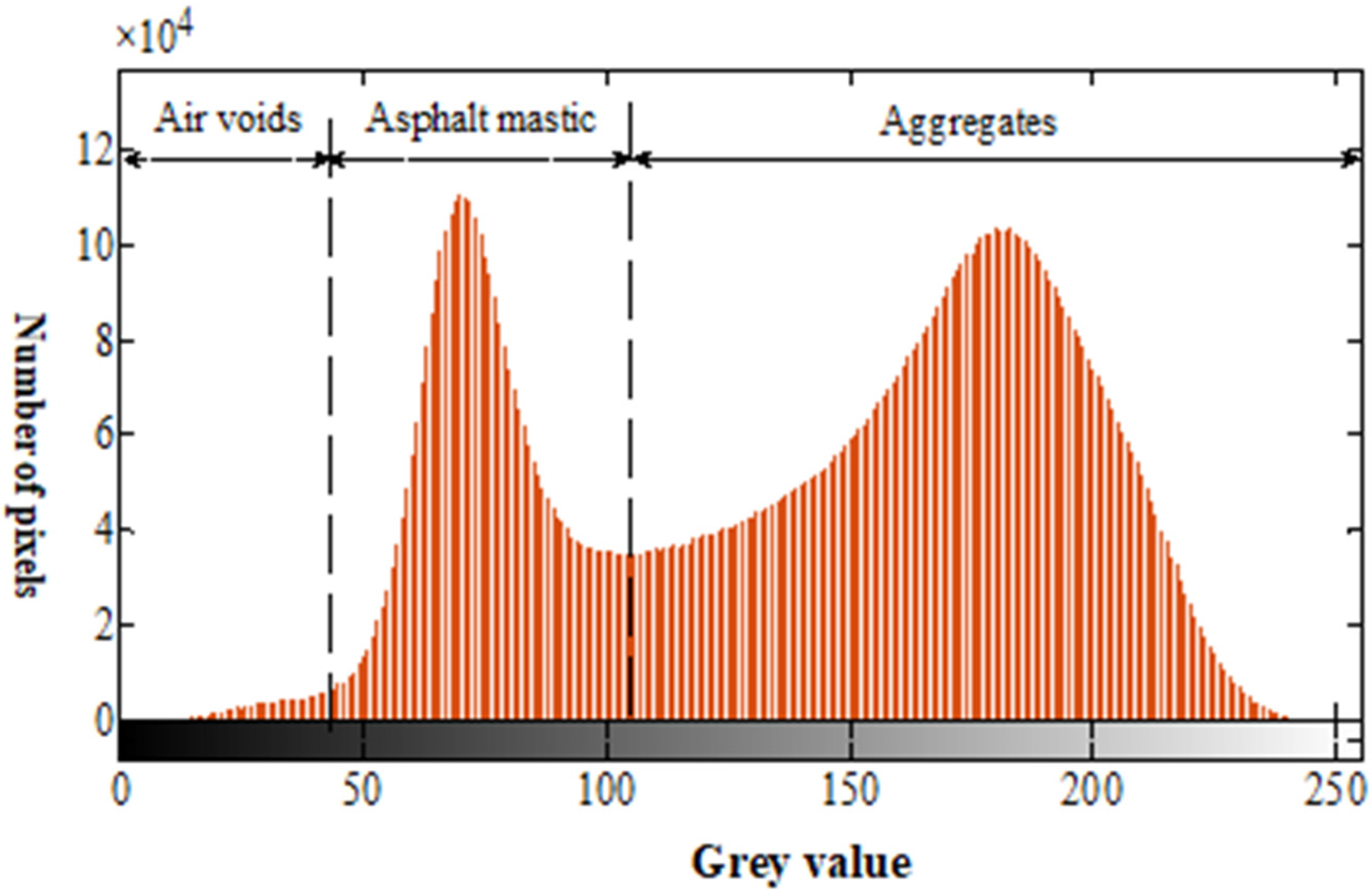

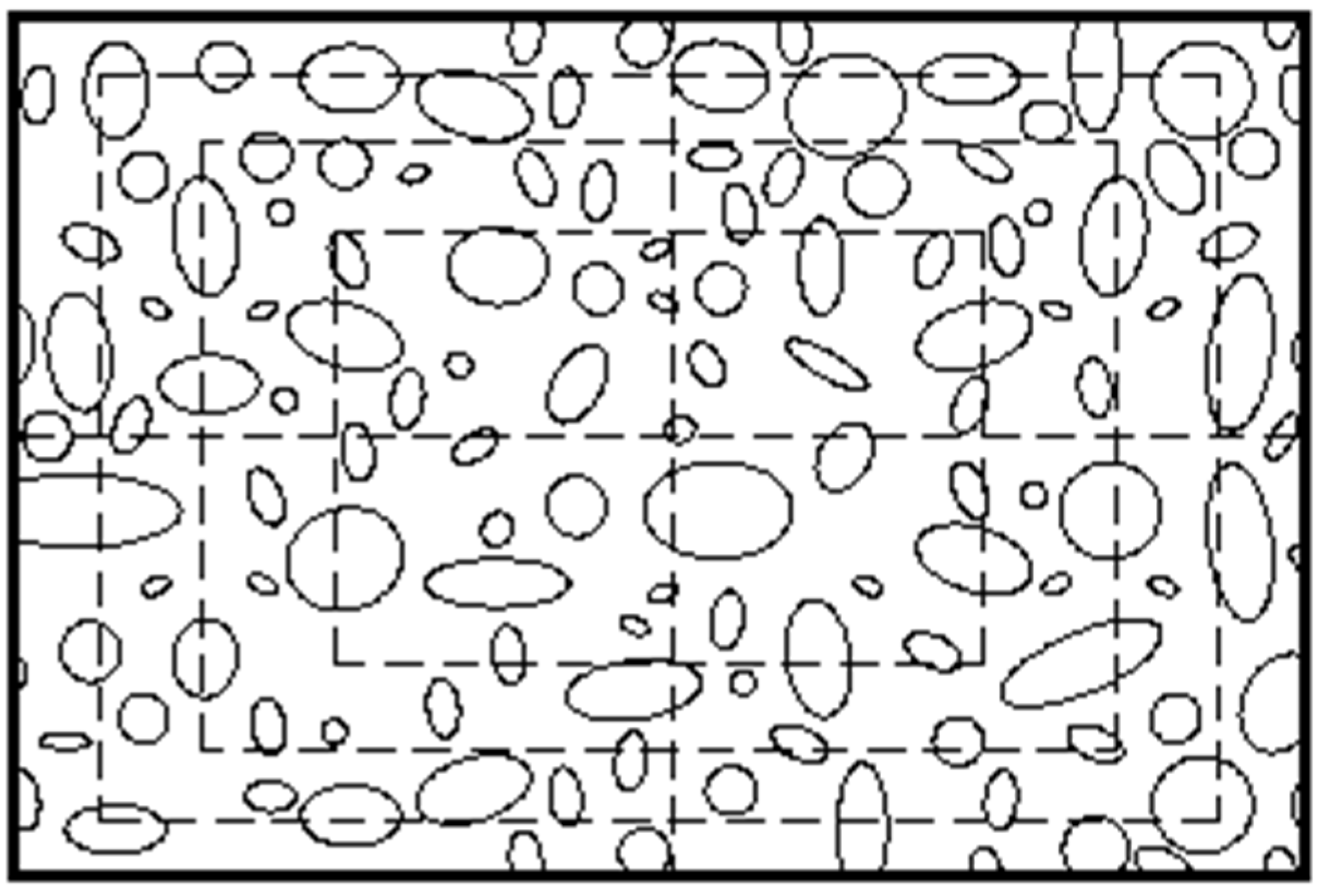

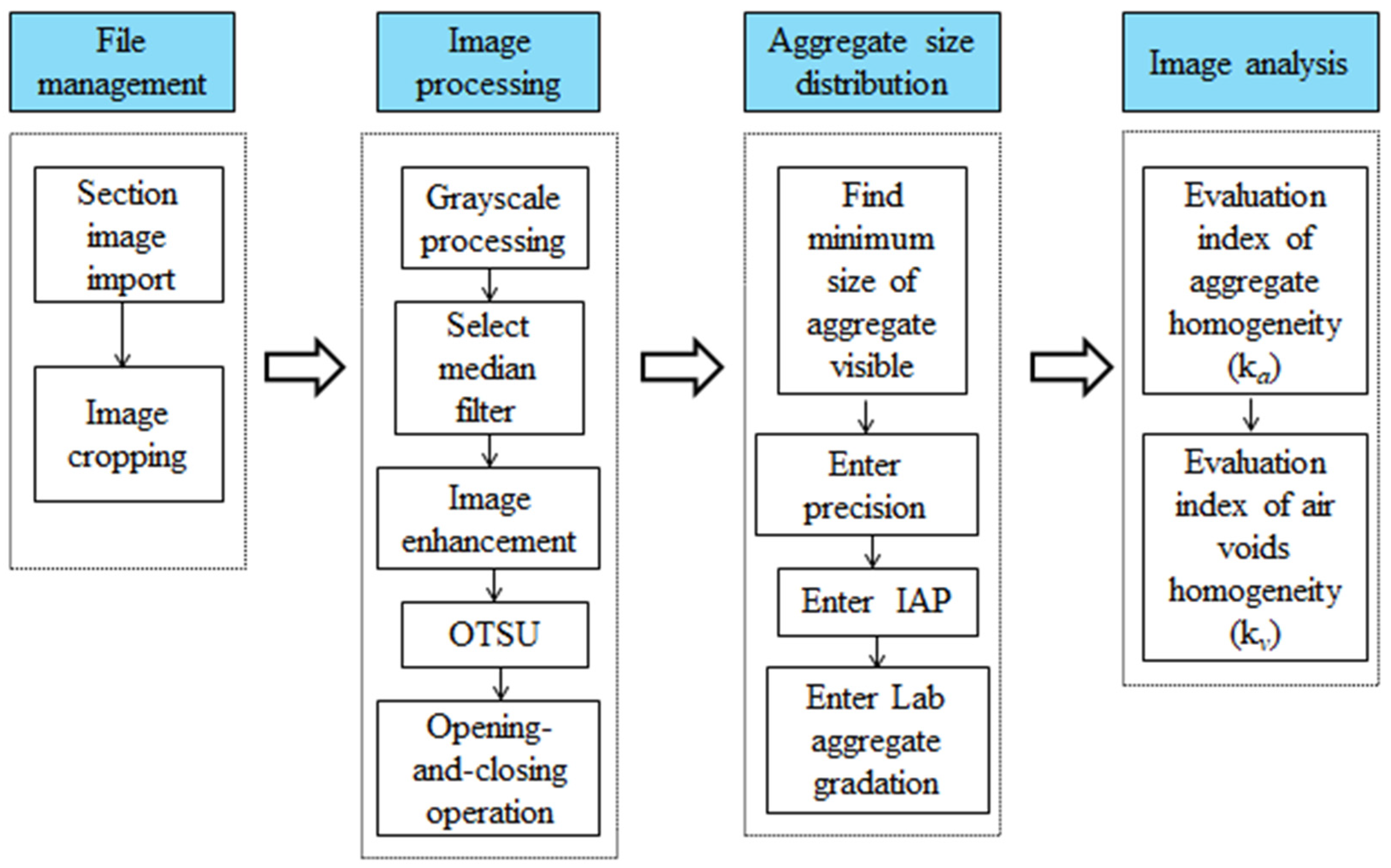
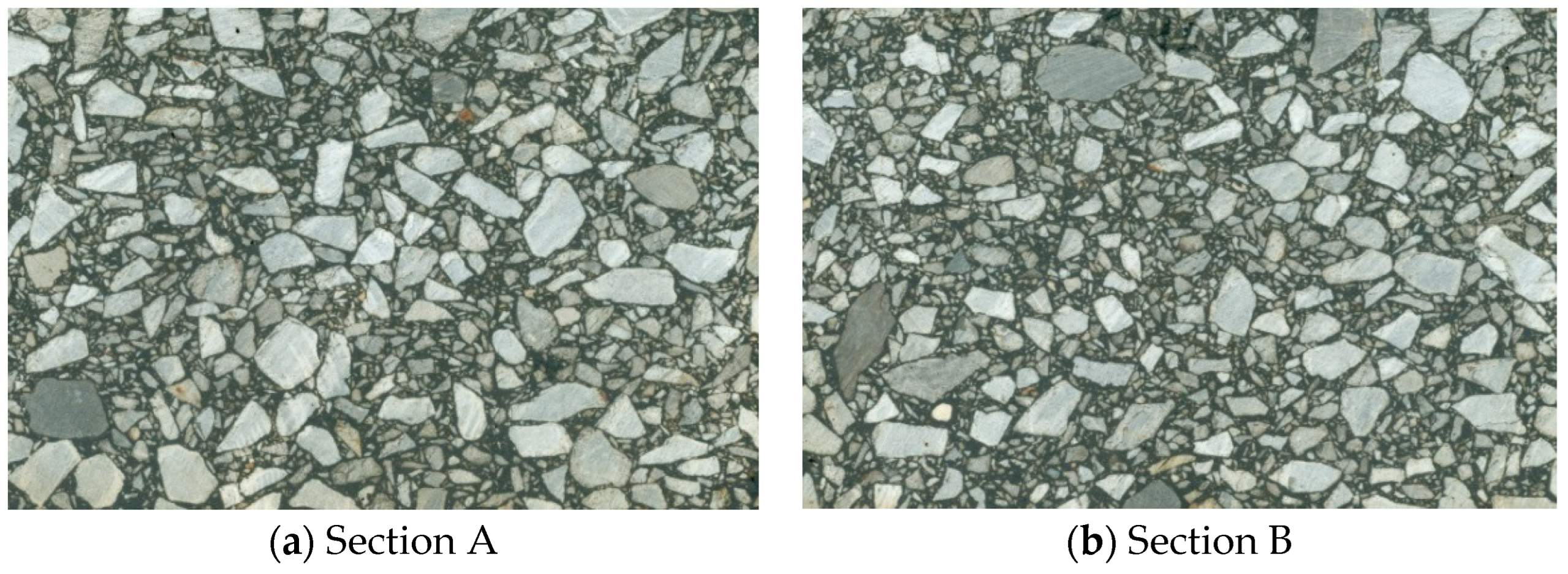
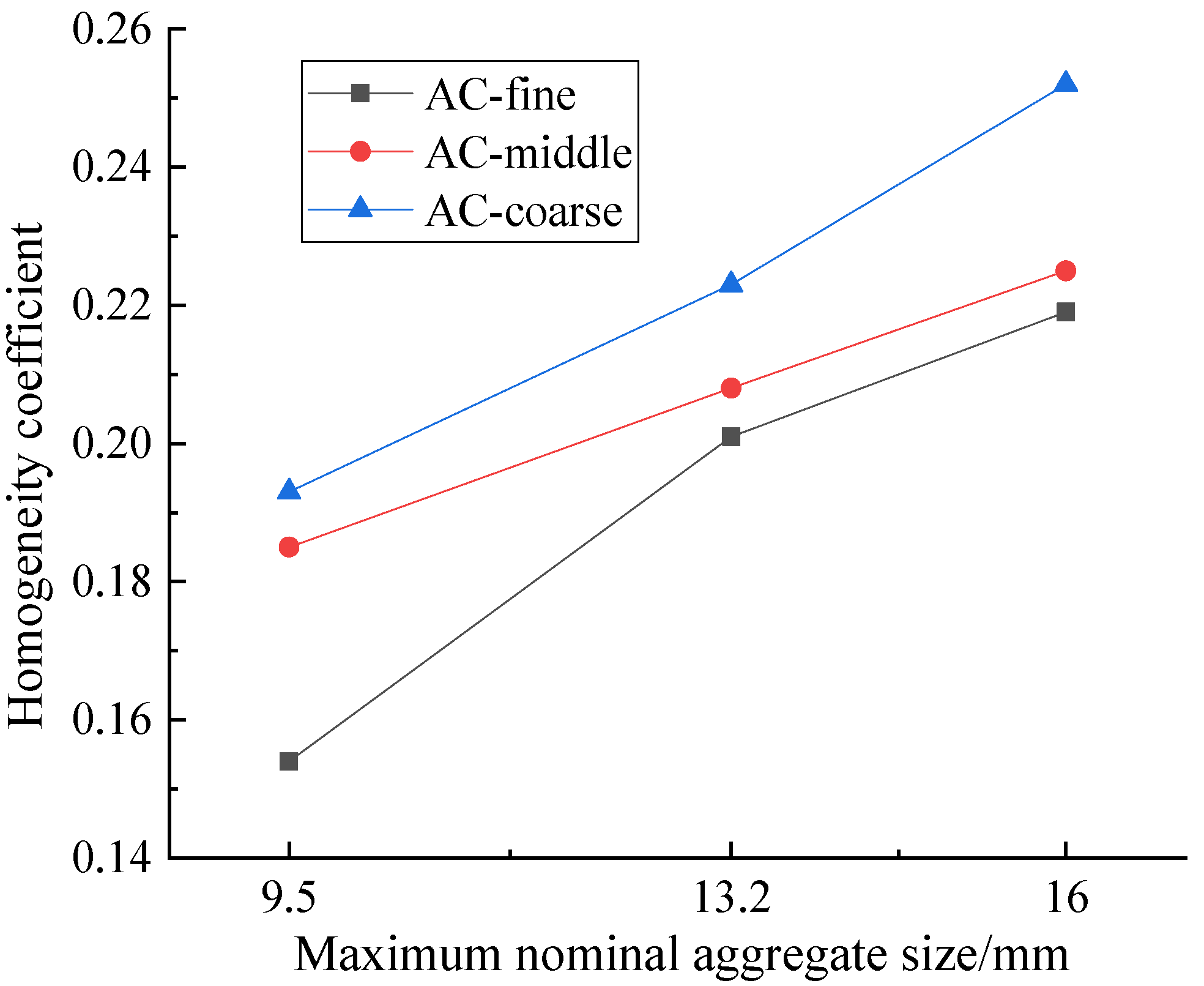

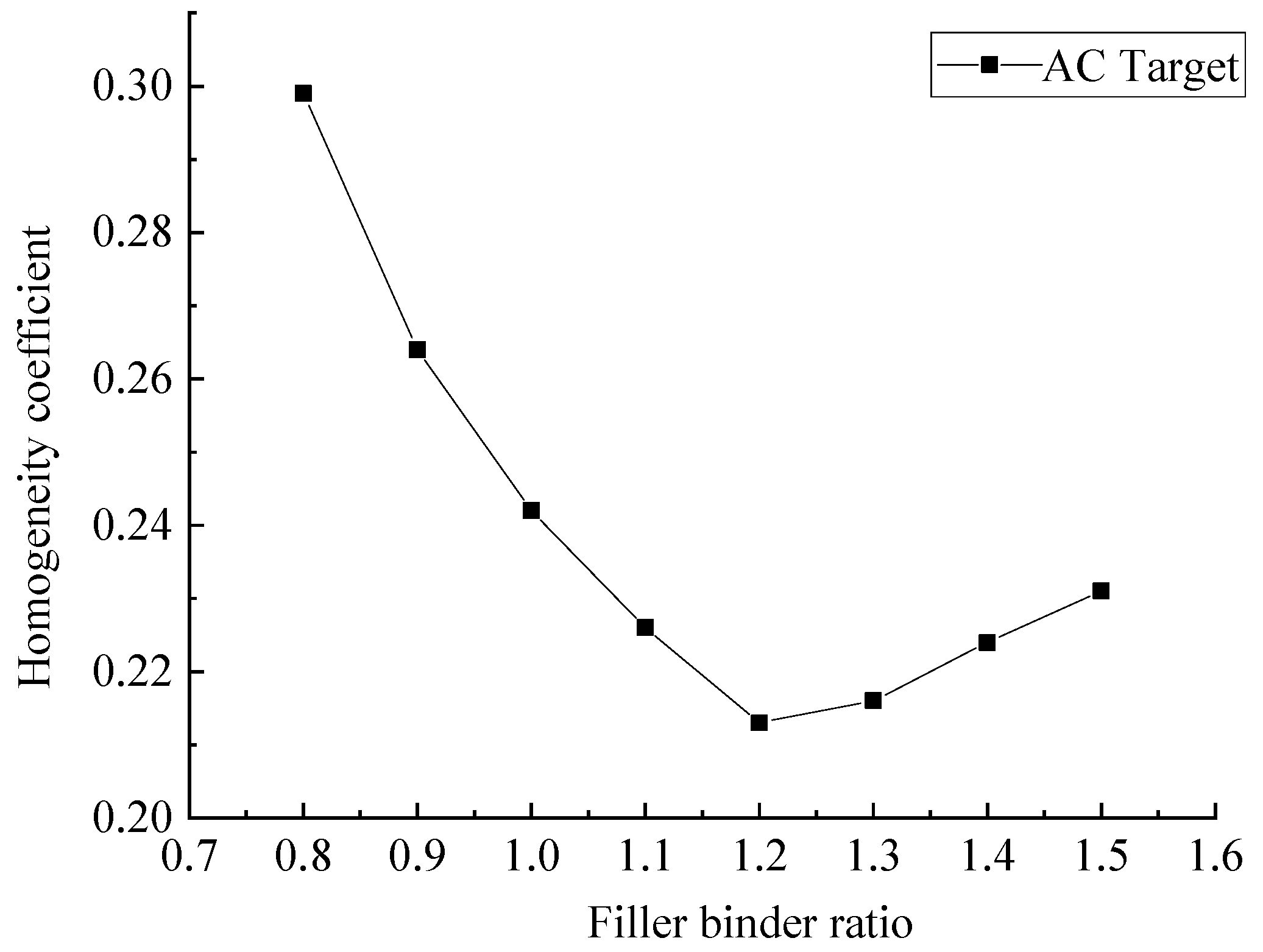
| Properties | SBS-Modified Asphalt | High-Viscosity SBS-Modified Asphalt |
|---|---|---|
| Penetration (25 °C, 5 s, 100 g)/0.1 mm | 71 | 64 |
| Softening point/°C | 57.5 | 76.5 |
| Ductility (5 °C)/cm | 32.4 | 49.8 |
| Density/(g/cm3) | 1.021 | 1.037 |
| Kinematic viscosity (135 °C)/Pa·s | 0.81 | 1.19 |
| Number | Aggregate Gradation | Nominal Maximum Aggregate Size | Asphalt- Aggregate Ratio (%) | Percent Air Voids | Notes |
|---|---|---|---|---|---|
| 1 | AC Coarse | 10 | 5.0 | 5.0 | Used to analyze the correlation of nominal maximum aggregate size and the homogeneity of asphalt mixture |
| 2 | AC Middle | 10 | 5.1 | 3.7 | |
| 3 | AC Fine | 10 | 5.2 | 2.8 | |
| 4 | AC Coarse | 16 | 4.5 | 6.1 | |
| 5 | AC Middle | 16 | 4.7 | 4.6 | |
| 6 | AC Fine | 16 | 4.9 | 3.5 | |
| 7 | AC Coarse | 13 | 4.7 | 5.5 | |
| 8 | AC Middle | 13 | 4.9 | 3.9 | |
| 9 | AC Fine | 13 | 5.1 | 2.9 | |
| 10 | SMA Coarse | 13 | 5.7 | 5.0 | Used to analyze the correlation of aggregate gradation and the homogeneity of asphalt mixture |
| 11 | SMA Middle | 13 | 5.9 | 3.5 | |
| 12 | SMA Fine | 13 | 6.1 | 2.6 | |
| 13 | OGFC Coarse | 13 | 4.5 | 22.9 | |
| 14 | OGFC Middle | 13 | 4.7 | 20.4 | |
| 15 | OGFC Fine | 13 | 4.9 | 18.7 | |
| 16 | AC Target | 13 | 7.5 | 1.0 | Used to analyze the correlation of asphalt content and the homogeneity of asphalt mixture |
| 17 | AC Target | 13 | 6.67 | 1.9 | |
| 18 | AC Target | 13 | 6.0 | 2.7 | |
| 19 | AC Target | 13 | 5.45 | 3.2 | |
| 20 | AC Target | 13 | 5.0 | 3.5 | |
| 21 | AC Target | 13 | 4.62 | 4.2 | |
| 22 | AC Target | 13 | 4.29 | 5.7 | |
| 23 | AC Target | 13 | 4.0 | 7.3 |
| Gradation Type | 19 | 16 | 13.2 | 9.5 | 4.75 | 2.36 | 1.18 | 0.6 | 0.3 | 0.15 | 0.075 |
|---|---|---|---|---|---|---|---|---|---|---|---|
| AC-10 Coarse | 100 | 100 | 100 | 91 | 49 | 34 | 23 | 16 | 11 | 7 | 5 |
| AC-10 Middle | 100 | 100 | 100 | 95 | 60 | 44 | 32 | 23 | 16 | 11 | 6 |
| AC-10 Fine | 100 | 100 | 100 | 99 | 71 | 54 | 41 | 29 | 21 | 15 | 7 |
| AC-13 Coarse | 100 | 100 | 91 | 70 | 42 | 28 | 18 | 13 | 9 | 6 | 5 |
| AC-13 Middle | 100 | 100 | 95 | 77 | 53 | 37 | 27 | 19 | 14 | 10 | 6 |
| AC-13 Fine | 100 | 100 | 99 | 83 | 64 | 46 | 35 | 25 | 18 | 14 | 7 |
| AC-13 Target | 100 | 100 | 96 | 78 | 44 | 33 | 23 | 17 | 11 | 9 | 6 |
| AC-16 Coarse | 100 | 91 | 78 | 63 | 38 | 24 | 16 | 11 | 9 | 6 | 5 |
| AC-16 Middle | 100 | 95 | 84 | 70 | 48 | 34 | 25 | 18 | 13 | 10 | 6 |
| AC-16 Fine | 100 | 99 | 90 | 77 | 58 | 44 | 33 | 24 | 16 | 13 | 7 |
| SMA-13 Coarse | 100 | 100 | 91 | 53 | 22 | 16 | 15 | 13 | 11 | 10 | 8 |
| SMA-13 Middle | 100 | 100 | 95 | 63 | 27 | 21 | 19 | 16 | 13 | 12 | 10 |
| SMA-13 Fine | 100 | 100 | 99 | 72 | 32 | 25 | 23 | 19 | 15 | 14 | 12 |
| OGFC-13 Coarse | 100 | 100 | 91 | 62 | 14 | 11 | 7 | 5 | 4 | 4 | 3 |
| OGFC-13 Middle | 100 | 100 | 95 | 70 | 21 | 16 | 12 | 10 | 8 | 6 | 4 |
| OGFC-13 Fine | 100 | 100 | 99 | 78 | 28 | 21 | 17 | 14 | 11 | 7 | 5 |
| Section Number | Actual Observation Result | k |
|---|---|---|
| a | The asphalt mixture is evenly distributed | 0.201 |
| b | Fine aggregates are concentrated in the middle region | 0.247 |
| Ideal section image | -- | 0 |
| Type of Asphalt Mixture | Suggested Value |
|---|---|
| AC-10 | [0.15,0.20] |
| AC-16 | [0.21,0.26] |
| AC-13 | [0.19,0.23] |
| SMA-13 | [0.14,0.20] |
| OGFC-13 | [0.16,0.22] |
Publisher’s Note: MDPI stays neutral with regard to jurisdictional claims in published maps and institutional affiliations. |
© 2022 by the authors. Licensee MDPI, Basel, Switzerland. This article is an open access article distributed under the terms and conditions of the Creative Commons Attribution (CC BY) license (https://creativecommons.org/licenses/by/4.0/).
Share and Cite
Sun, P.; Zhang, K.; Han, S.; Liang, Z.; Kong, W.; Zhan, X. Method for the Evaluation of the Homogeneity of Asphalt Mixtures by 2-Dimensional Image Analysis. Materials 2022, 15, 4265. https://doi.org/10.3390/ma15124265
Sun P, Zhang K, Han S, Liang Z, Kong W, Zhan X. Method for the Evaluation of the Homogeneity of Asphalt Mixtures by 2-Dimensional Image Analysis. Materials. 2022; 15(12):4265. https://doi.org/10.3390/ma15124265
Chicago/Turabian StyleSun, Pei, Ke Zhang, Sen Han, Zijun Liang, Wei Kong, and Xuejuan Zhan. 2022. "Method for the Evaluation of the Homogeneity of Asphalt Mixtures by 2-Dimensional Image Analysis" Materials 15, no. 12: 4265. https://doi.org/10.3390/ma15124265







